How to Protect Your Kids on Social Media
Social media surrounds us. Companies and television networks target teens to use social media by liking, following, or tweeting about products and shows. Social media is also a great place to keep up with family and friends. While there is...
Method 1 of 3:
Talking To Your Child About Social Media Safety
-
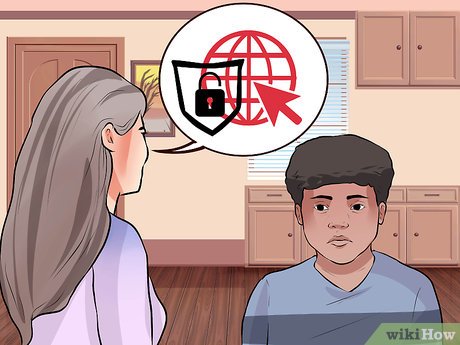 Have a conversation about social media safety. Communicating with your child is important. You want your child to feel comfortable talking to you about social media and their experiences on it, along with feeling like they can come to you if they has a problem. Open the lines of communication so your child will feel comfortable coming to you about any problems.[1]
Have a conversation about social media safety. Communicating with your child is important. You want your child to feel comfortable talking to you about social media and their experiences on it, along with feeling like they can come to you if they has a problem. Open the lines of communication so your child will feel comfortable coming to you about any problems.[1]- Explain to your child about being safe on social media. Tell them not to give out personal details, like their full name, the name of their school, their phone number or their address. Help them understand the importance of not posting inappropriate pictures or updates. Make sure to have a discussion about the dangers of cyber predators and why they should never meet people they only know online in person.
-
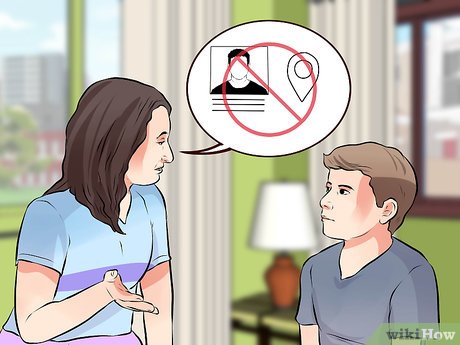 Set rules for your child. Talk to your child about what rules you have concerning social media. These rules can include anything you are concerned about.[2] Examples include:
Set rules for your child. Talk to your child about what rules you have concerning social media. These rules can include anything you are concerned about.[2] Examples include:- Not allowing your child to post about where they are.
- Not allowing your child to post any personal details.
- Limiting the amount or kinds of photos your child posts.
- Setting an amount of time your child can spend on social media.
- Restricting which social media sites your child can become a member of.
- Only allowing your child to follow or friend people they know in person, like classmates or family members.
- Sharing their passwords for all accounts with you.
-
 Discuss the repercussions of social media. You don't just need to worry about predators finding your child. You need to discuss with your child how to keep themselves safe from themselves. Posting embarrassing, questionable, or inappropriate pictures can cause potential colleges and employers to reject them. Posting status updates that are rude, offensive, or questionable can also come back to haunt them later.[3]
Discuss the repercussions of social media. You don't just need to worry about predators finding your child. You need to discuss with your child how to keep themselves safe from themselves. Posting embarrassing, questionable, or inappropriate pictures can cause potential colleges and employers to reject them. Posting status updates that are rude, offensive, or questionable can also come back to haunt them later.[3]- Make sure to discuss with your child that once they put something on social media, it is out in the world and difficult to remove or take back.
- Speak with your child openly about social media and encourage a trusting environment. Ask your child to talk to you about their social media usage and anything that makes them uncomfortable. If they make a mistake, turn it into a teaching moment instead of enacting a harsh punishment.[4]
Method 2 of 3:
Protecting Your Child On Social Media
-
 Wait until your child is old enough to get a social media account. All social media sites have minimum age requirements to be able to sign up for an account. These ages are put into place to protect the privacy of children and young people. Make sure not to allow your child to have a social media account when they are younger than the required age. When they reach the minimum age, decide if you feel they are mature enough to sign up for an account.[5]
Wait until your child is old enough to get a social media account. All social media sites have minimum age requirements to be able to sign up for an account. These ages are put into place to protect the privacy of children and young people. Make sure not to allow your child to have a social media account when they are younger than the required age. When they reach the minimum age, decide if you feel they are mature enough to sign up for an account.[5]- For Facebook, Twitter, Instagram, Tumblr, Snapchat, and Pinterest, a person must be 13 to get an account. Although YouTube requires a person to be 18, someone who is 13 can sign up with parental permission.
- Vine and Tinder require a person to be 17 to hold an account.
-
 Friend or follow your child. When your child has a social media account, friend or follow that account. Talk to them about which sites they are using, and if you don't understand how the site works, have your child explain it to you. This can help you monitor what your child is doing online and who they are talking to.[6]
Friend or follow your child. When your child has a social media account, friend or follow that account. Talk to them about which sites they are using, and if you don't understand how the site works, have your child explain it to you. This can help you monitor what your child is doing online and who they are talking to.[6]- Your child might have social media sites you don't know about. Browse through downloaded apps on their phone or watch which apps they're using to see what social media sites they are a member of.
- Be aware some social media sites have options that allow members to choose who sees the posts. You child might be following or friended with you, but they could filter the post so you can't see it.
- You also might be able to see what their interests are or if something is wrong with your child by reading their posts.
-
 Allow your child the right amount of privacy. As your child grows up, you want to give them privacy and trust them. This means not going behind their back and checking on everything they do. However, you should keep an eye on what your child does online.[7]
Allow your child the right amount of privacy. As your child grows up, you want to give them privacy and trust them. This means not going behind their back and checking on everything they do. However, you should keep an eye on what your child does online.[7]- When younger teens get social media sites, make sure to get their passwords for the sites. This can help you watch over their online activities. For older teens, you may allow them more privacy by letting them have their own private passwords.
- Check their Internet history. This will show you what sites your teen has been visiting. You can also check your child's phone. However, this may cause a problem with your child if they believe you are invading their privacy and not trusting them. Use your judgment for how often and when you check these things. You may hold checking Internet and phone histories for when your child gives you a reason to not trust them or when you believe their privacy is at risk.
- You can also install apps such as Net Nanny or WebWatcher. Your child will never know these apps are on the computer, and they will alert you to things that may jeopardize the safety of your child.[8]
-
 Have a shared computer. Another way to keep your child safe on social media is to have a shared computer. This means the child doesn't have their own laptop in their room where they can hide what they do from you. Instead, they use the computer in a central location in the house where you can monitor what they do.[9]
Have a shared computer. Another way to keep your child safe on social media is to have a shared computer. This means the child doesn't have their own laptop in their room where they can hide what they do from you. Instead, they use the computer in a central location in the house where you can monitor what they do.[9] -
 Make sure global location settings are off. To protect your child, turn off the location settings. Location settings allow social media sites to add the location of the person when they post a photo or an update. By turning this off, it keeps people from knowing exactly where your child is and places they frequent often.[10]
Make sure global location settings are off. To protect your child, turn off the location settings. Location settings allow social media sites to add the location of the person when they post a photo or an update. By turning this off, it keeps people from knowing exactly where your child is and places they frequent often.[10]- Location settings may post the city that the person is in, the name of restaurant or store, or even the address.
-
 Learn text language. Social media, text, and sexting have their own language. Knowing some of the language, or know where to look up acronyms, may help you really know what your child is talking about. Sexting particularly has its own language, and parents should be aware of this so they can address the situation if it arises.[11]
Learn text language. Social media, text, and sexting have their own language. Knowing some of the language, or know where to look up acronyms, may help you really know what your child is talking about. Sexting particularly has its own language, and parents should be aware of this so they can address the situation if it arises.[11]
Method 3 of 3:
Protecting Your Child's Privacy On Your Social Media Account
-
 Use privacy settings. If you have a social media account, you probably want to share photos of your children. You do this because you love them and are proud of them. But sharing photos of your children might be putting them at risk. When you share photos of your kids, use the privacy settings for the photos so you can control who sees your photos.[12]
Use privacy settings. If you have a social media account, you probably want to share photos of your children. You do this because you love them and are proud of them. But sharing photos of your children might be putting them at risk. When you share photos of your kids, use the privacy settings for the photos so you can control who sees your photos.[12]- Use settings to allow only the people you follow to see your photos. You can also set custom privacy settings, where you choose who you want to see the photos.
- You may also consider making your entire social media account private so you will know who sees your information.
-
 Avoid using GPS tagging. Your child is not the only one who needs to turn off location settings. You should also turn off location settings when you post pictures of your child. By keeping the location of your child off of social media, you protect them from potential predators.
Avoid using GPS tagging. Your child is not the only one who needs to turn off location settings. You should also turn off location settings when you post pictures of your child. By keeping the location of your child off of social media, you protect them from potential predators. -
 Refrain from friending strangers. Social media is used to meet new friends, and some people even use it to play games with strangers. If you post pictures of your child or talk about them, refrain from friending people you don't know. Don't accept friend requests from people you don't know. You never know if someone is a predator or not.
Refrain from friending strangers. Social media is used to meet new friends, and some people even use it to play games with strangers. If you post pictures of your child or talk about them, refrain from friending people you don't know. Don't accept friend requests from people you don't know. You never know if someone is a predator or not.- Talk to your child about accepting friend requests from strangers. Encourage them to never friend strangers. Regularly review the list of people your child is friends with or follows. Ask them about any new additions or unknown people.
-
 Take caution with the information you share. People often overshare on social media. This includes details about their children. You should never give away personal details, such as your child's full name, the school they attend, their birthday, or other details. These things may seem benign, but they can put your child at risk.
Take caution with the information you share. People often overshare on social media. This includes details about their children. You should never give away personal details, such as your child's full name, the school they attend, their birthday, or other details. These things may seem benign, but they can put your child at risk. -
 Post smaller pictures. If you want to post pictures, make sure to post pictures at a lower resolution. This can help reduce the risk of someone printing it out or enlarging it.[13]
Post smaller pictures. If you want to post pictures, make sure to post pictures at a lower resolution. This can help reduce the risk of someone printing it out or enlarging it.[13]- If you are really concerned about people stealing photos of your child, place a watermark on your photos.
-
 Refrain from posting pictures of other children. When your child has a party or a sleepover, make sure to never post pictures of other people's children. Only post photos of your own child. If you want to post photos from a party with someone's child in it, make sure to discuss that with that parent first.[14]
Refrain from posting pictures of other children. When your child has a party or a sleepover, make sure to never post pictures of other people's children. Only post photos of your own child. If you want to post photos from a party with someone's child in it, make sure to discuss that with that parent first.[14]
4 ★ | 8 Vote
You should read it
- 9 misunderstand about social networks
- 5 social media trends in 2014
- How to Blog Respectfully About Your Disabled Child
- 21 Social Media Marketing experts on Twitter need to 'follow' immediately
- How to Help a Carsick Child
- How to Support Social Development in Young Children
- The legality of Social Media Background Checks
- A Comprehensive Guide To Emojis In Social Media Marketing
- TikTok is under investigation for the use of child data
- AI uses tweets to help researchers analyze the flood situation
- Android malware believed to be spreading from Vietnam has attacked more than 10,000 Facebook accounts in 140 countries
- Facebook dropped out of the top 3 social networks most used by young Americans
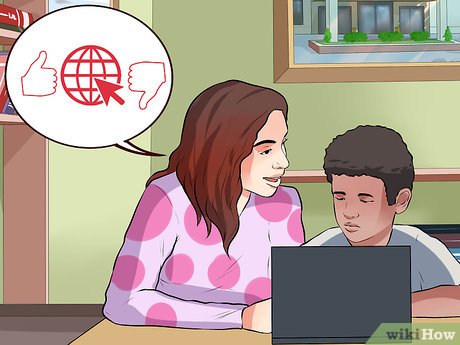
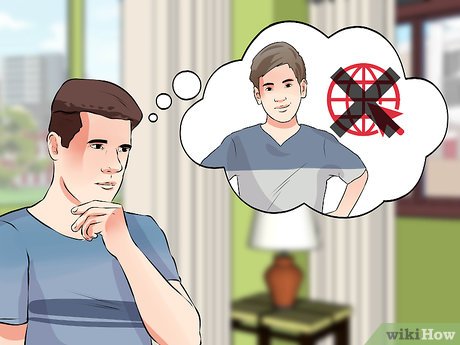

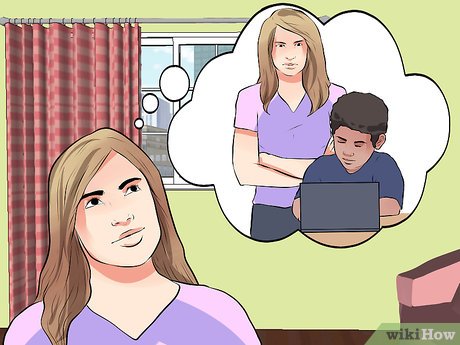
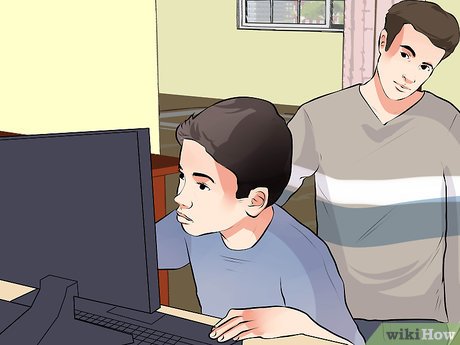


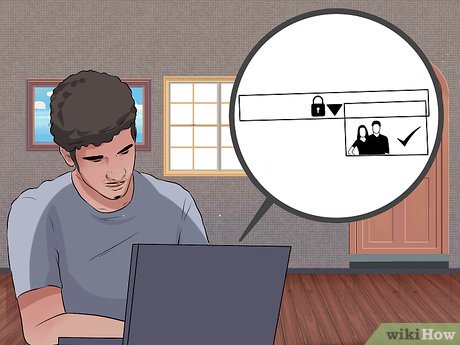
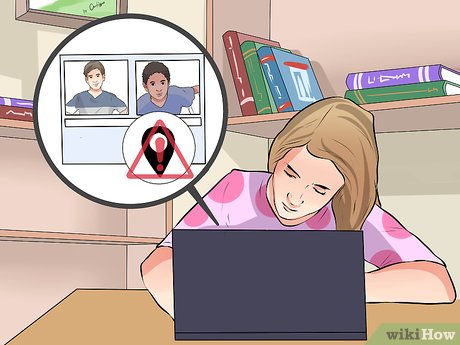
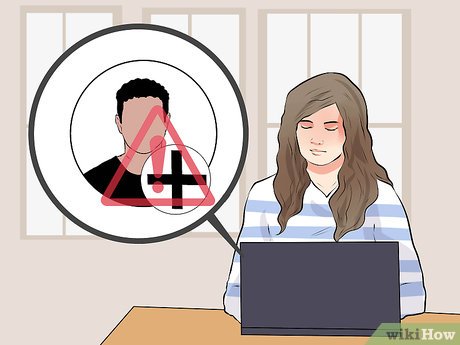
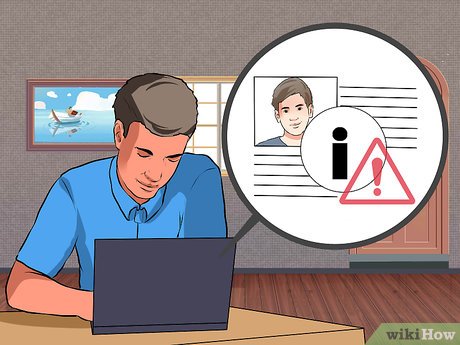
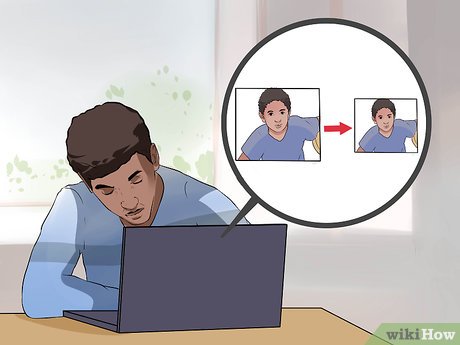
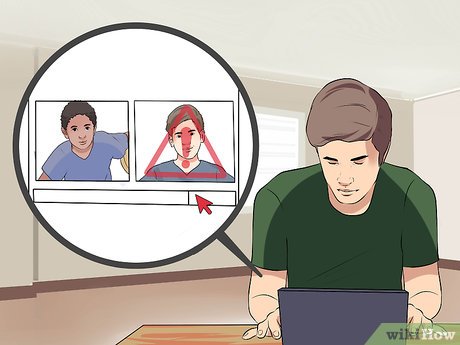






 5 social media trends in 2014
5 social media trends in 2014 Advertising is making people use social media less
Advertising is making people use social media less 5 Ways to Cut Down on Social Media Usage
5 Ways to Cut Down on Social Media Usage 9 misunderstand about social networks
9 misunderstand about social networks 21 Social Media Marketing experts on Twitter need to 'follow' immediately
21 Social Media Marketing experts on Twitter need to 'follow' immediately The legality of Social Media Background Checks
The legality of Social Media Background Checks